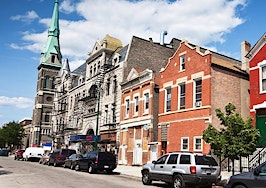- Illinois' first-time homebuyers average an income of $71,200 per year.
- First-time homebuyers in Illinois plan to stay in their homes for six years, compared to nine years for overall users.
- A 20 percent down payment for a median priced starter home in Chicago is $19,750 -- 13 percent less than what millennials expect to pay upfront.

Near North Side, Chicago/Flickr user randz
Millennial buyers face strong headwinds at the moment when trying to acquire their first properties. Low inventory, rising home prices, lack of wage growth and heavy competition make entry-level home buying difficult, something many of Chicago’s first-time homebuyers are finding out right now.
Although Chicago’s first-time homebuyers often struggle, many young professionals are walking the path to homeownership in The Windy City. Residential construction in Chicago is on the rise, with a 33 percent year-over-year jump in the metro area, and the city saw a rise in median sale price to reach $168,500 in March.
MortgageHippo, a mortgage application and loan service based in Chicago, broke down various traits of first-time homebuyers in Illinois — many of whom fall into the millennial generation. The bulk of the company’s Illinois users come from Chicago, where prices and salaries trend higher.
Traits of Chicago’s first-time homebuyers
Illinois’ first-time homebuyers average an income of $71,200 per year, higher than the average $65,000 for all 5,000 first-time buyers using MortgageHippo nationally; the average credit score for Illinois users matches the national average at 730.
“Mortgage hippo is very tech focused, so we get a lot of tech-savvy people who tend to be young professional or higher earners,” MortgageHippo CEO Valentin Saportas said.
The company also found that first-time buyers in Illinois put a larger down payment on homes, at $16,000 compared to $15,000 nationally. However, they have the same available assets, with $20,000 on average.
[Tweet “Illinois first-time buyers put a larger down payment on homes than the national average”]
“At MortgageHippo, the average loan amount is close to the national average of $250,000,” Saportas said. “In urban areas like Chicago, however, it’s a little higher than the national average.”
First-time homebuyers in Illinois plan to stay in their homes for six years, compared to nine years for overall users. Why the disparity? Saportas says it comes down to the lifestyle of Chicago’s first-time homebuyers versus suburban or rural areas, where buyers are more likely to put down roots.
“In Chicago, if you’re a young professional, you might be seriously dating or married without kids,” he said. “But that’s a very different homebuyer than somebody who is getting ready to settle down.”
Estimates vs. reality in Chicago
While the homeownership dream is alive, especially among millennials, a recent study by Apartment List found 75 percent of young Chicagoans who want to buy can’t afford it right now.
However, they may be miscalculating costs. A 20 percent down payment for a median priced starter home is $19,750 — 13 percent less than what Chicago millennials expect to pay upfront.
Millennials in Chicago with dreams of homeownership tend to overestimate the down payment cost, and the study found it would take millennials homebuyers 5.4 years to save — far less than in Boston or New York, where it would take them 10.1 and 10.4 years, respectively.
Down payment assistance for first-time homebuyers
While Chicago falls fairly in line with national trends, and homebuying isn’t as pricey as other metros, student loan debt and high rents still create investment delays.
[Tweet “Student loan debt and high rents still create investment delays”]
“If you’re looking at $400,000 — pretty average for many places in Chicago — and looking to put 3 percent down as a first-time homebuyer, that’s already $12,000.” Saportas said.
Plus, Saportas says buyers need to factor in another 3 percent for closing costs and financial reserves.
“How many people have an extra $24,000 there after making all the student loan payments?” he said.
While down payment assistance can help reach 3 percent, many aren’t approved. For the majority of down payment assistance programs, Saportas says the requirement is earning below the area’s median income.
“I feel that if more professionals also fully understood down payment assistance programs and the consumer understood them, there would be a better fit here for millennial home buyers,” he said. “It comes down to education.”








